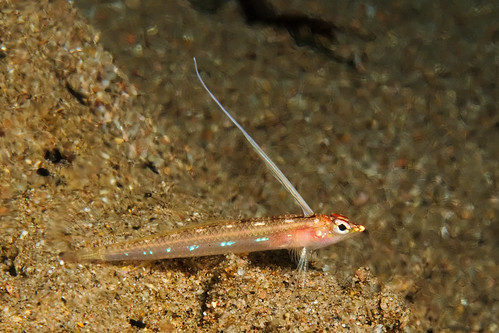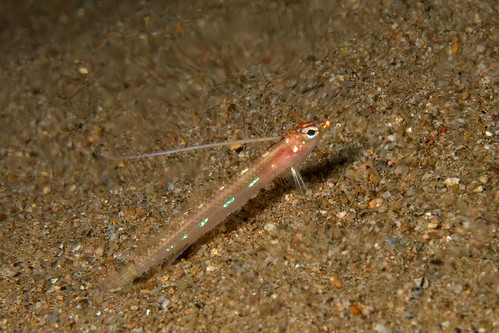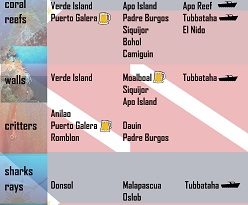Pearly Signalfish
One of the things which fascinates me about diving in Dauin, on Negros Island in the Philippines, is the incredible diversity of small fishes, some of which are extremely rare in almost all other places I have dived, or even absent from these other spots.
The Pearly Signalfish
Yesterday I had the great pleasure to observe a pearly signalfish – this fish looks like a goby with an extremely elongated dorsal fin. In fact, the fish is not a goby but belongs to the duckbills (see below). This is the only ever duckbill fish I have seen, anywhere. It’s a small fish (~ 3 cm) living in the sand or rubble.
This is the FishBase page for the duckbill family of fishes, and this is the page for the peary signalfish. Also check out this excellent article about the duckbills, especially about their taxonomy, which concludes that these are not gobies, even though they might sort-of, kind-of look like gobies…
This is a pearly signalfish with its dorsal fin up. Spectacular! The fin is almost the length of the whole fish!
Communication
What fascinates me about the pearly signalfish is that they signal each other by flipping up their long dorsal fins, almost like in a Morse code. The small fish position themselves next to each other sideways, a few centimeters apart, and flick once every few seconds. What is the grammar of these fin flicks? Is it simply the frequency of flicks which counts in determining a hierarchy among the signalfish, or is the exact sequence of flicks important as well? Is this a territorial signaling system, or are these mating displays, or both?
There are signalfish with very long dorsal fins, almost the length of the fish, and a second group with a thicker but shorter fins, with some pigment along the fin’s length. I believe the latter group are the females.
In any case, the signalfish dorsal fin has ceased to be a hydrodynamic stabilizer, like dorsal fins are in free-swimming fishes like trevalleys or tunas. These tiny, sand-living fishes seem to never swim in mid water, but rather dart along the surface of the sand, and are hence not in need of such a stabilizer. Also, the physics of locomotion works differently when you are as small as a pearly signalfish, as explained in this video:
The dorsal fin of the pearly signalfish has become a communication, not a swimming organ. I am really hoping to get some video footage of these fishes and their fin-flick communication soon!
If you are in Dauin and you’d like to try to find them yourself, they reside in Poblacion, at ~ 25 meters, in the sandy/rubble area just north of the coral reef. I have not seen them shallower, and the duckbills generally seem to be deeper-water fishes.
Note the swirls in the background, these are convection currents from the geothermal heating of the sand.
This, I believe, is a female pearly signalfish. You can tell by the shorter dorsal fin, which here is not raised.
Amazing little fish! To me, small rare natural jewels are at least as fascinating as big sharks or manta rays.




